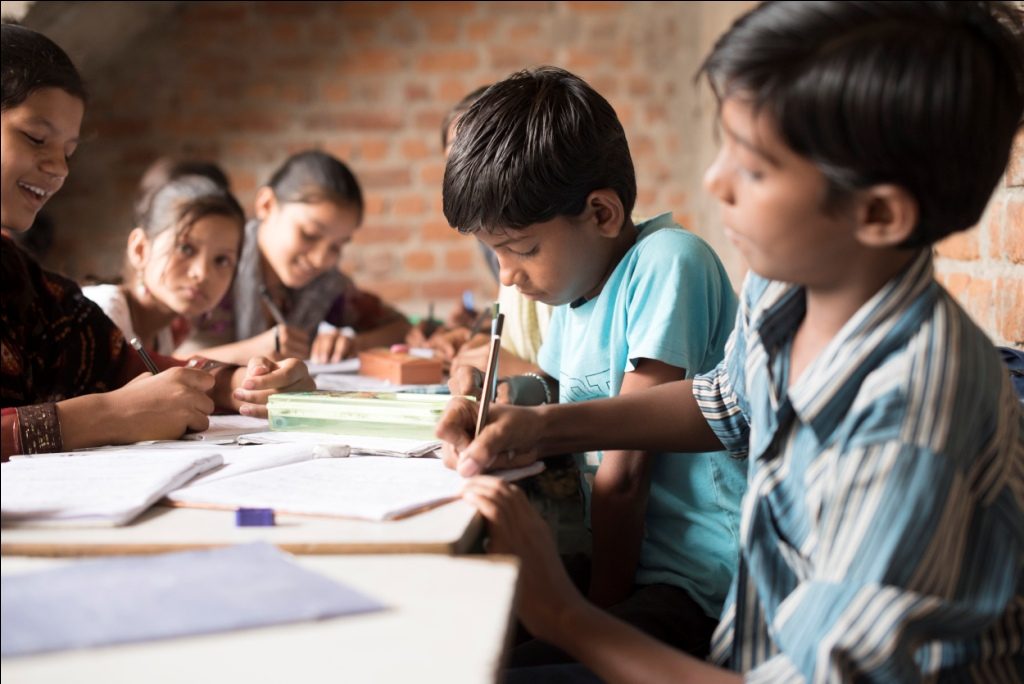MIDDLE SCHOOL PROGRAM (Grades 4-7)
After stabilizing its elementary program through three annual reviews and redesign of various program components, Gyan Shala started middle school program in 2005-06 on a small scale. This has grown to 126 classes with an enrolment of 2648 children, in 2017-18.
Gyan Shala management recognizes that evolving middle school program poses the greatest design and management challenges, since this program covered the (i) the initiation of formation of most concepts in human/ child’s mind, (ii) transition of a child into adolescence, whose consequences are difficult to deal with without quality parental support, and (iii) using teachers from human resource pool from a broken down university system, whose students simply have not learned the process of self-learning and core subject expertise.
The first challenge requires teachers to have subject expertise of significant depth, which most individuals cannot be expected to have in many subject streams, spanning language-math-science-social studies. This program, therefore, needed specialist subject teachers for each stream, while in elementary stage; one class teacher could oversee and facilitate the learning tasks in all the subject streams. Further, the learning tasks in an elementary program could be handled by teachers with grade XII education, but middle school teachers required a greater depth of subject knowledge, requiring graduate-level education, and specialization in one particular subject. A minimum of 4-5 teachers taught in each middle school class. The third challenge required the program to invest in teacher training much more than in the elementary program and building high-quality conceptual foundation among the teacher trainers, who could help teachers to overcome the gaps in their university education to a certain extent. Building high-quality conceptual foundation among teacher training, in turn, required building a learning culture in the curriculum design cum teacher training team, which had to be of much higher order than of elementary team. In addition to annual training, the teachers were provided training session with the curriculum design team every fortnight. There was no position/ role of a senior teacher, but like the elementary program, the classes were held in a room close to children’s home, which had the required class facilities and furniture for each child.

But, unfortunately, the household responsibility of most children does not permit them to devote any more than 4 hours of class time to their studies, with other time spent on supporting their household’s economy. It is typical for children to contribute to the running of a household, or its economy after they cross ten years of age.
As yet, Gyan Shala has not discovered an effective mix of large-scale financing of the middle school program. There is no Govt. scheme under which this program could be supported even by sympathetic officers. We charge Rs. 100-150/- per month from the parents, which is close to the top of the paying capacity of poor parents that Gyan Shala serves, but it amounts to only 5% of program cost. No child, though, is denied education in case of inability to pay. The donor support is also deterred by the perception that this program might be violating RTE provisions which it does not.
Main features:
- Classrooms nearby homes/ communities, so allowing more girls of teen age to continue studies
- Curriculum content made suitable to the child’s natural learning style
- Pedagogical approaches adapted for the needs of the children with key lessons learned from the successful examples across World (from programs and experts)
- Use of human resources available locally and easily at each level
- Regular (fortnightly) extensive training of all categories of the staff
- Subject specific grade wise teachers
Towards the end of 2017-18, around 2648 children studied in around 126 classes in various slums in two cities across 2 states. The proportion of girls and boys in Gyan Shala remained almost equal and minority representation exceeded their proportion in the populations-geographies served (more than 60% for backward classes).
In 2017-18, the middle school program had classes covering 2600 children, as per details in the following table below.
| Grades | Centers | Children | Boys | Girls | Yearly Average Cost per Child (INR) |
| 4 | 46 | 1152 | 515 | 637 | 6261
|
| 5 | 31 | 618 | 288 | 330 | |
| 6 | 24 | 435 | 209 | 226 | |
| 7 | 24 | 443 | 198 | 245 | |
| Total | 126 | 2648 | 1210 | 1438 |
Detailed student assessment reports for the period 2009-2018 can be accessed through the ‘External Assessments’ tab in the ‘Reports’ section.
